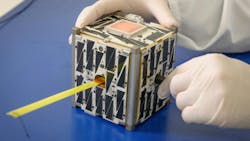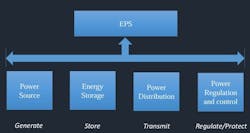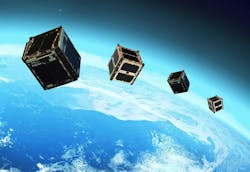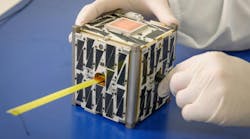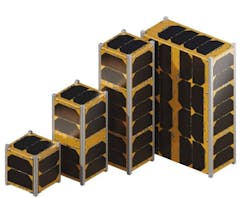Power Density in NASA Small Spacecraft Systems
What you'll learn:
- Electrical power systems in spacecraft.
- Power density of CubeSats and SmallSats.
- What is a CubeSat?
- Solar-panel power for small satellites.
Electrical power system (EPS) designs for NASA’s spacecraft have a powerful and essential subsystem that surrounds the electrical power generation, storage, and distribution. It encompasses a large portion of volume and mass in any spacecraft.
Continuously powering these electrical subsystems requires solid power density. Controlling the generated power while focusing on capability gaps that may exist within the spacecraft transportation power systems, especially for astronaut exploration vehicles, requires high-efficiency power systems, as well as surface nuclear and mobile power systems.
Electrical Power Systems in Spacecraft
The spacecraft EPS must safely supply continuous power to all subsystems throughout the mission life, which includes eclipses as well as adequate nighttime power. And it must provide enough power margin during average as well as peak loads.
Power converters have to supply downstream energy for various voltage loads. And bus isolation is critical between upstream and downstream loads. EPS health and status must be provided, too, such as current, voltage, temperature, and more. A typical EPS subsystem is shown in Figure 1.
NASA spacecraft power-generation technology encompasses such things as photovoltaic cells, panels and arrays, and radioisotope or other thermonuclear power generators. Power storage is usually applied via batteries such as single-use primary batteries or rechargeable secondary batteries.
NASA’s power management and distribution (PMAD) systems strongly promote power control to all spacecraft electrical loads. These loads take on an assortment of forms that are typically custom-designed to meet specific mission requirements.
EPS engineers will typically target a high specific power or power-to-mass ratio watt-hour per kilogram (W-h/kg) when selecting power-generation and storage technologies that will minimize system mass. The EPS volume will most likely be the constraining factor for nanosatellites.
Power Density of CubeSats and SmallSats
NASA CubeSats are nanosatellites in a standard size and form factor (Fig. 2).
SmallSats, for instance, have a mass that’s usually smaller than 180 kg—they’re generally the size of a large refrigerator. They come in a variety of sizes and mass, listed in descending size order below:
- Mini-satellite, 100-180 kg
- Microsatellite, 10-100 kg
- Nanosatellite, 1-10 kg
- Picosatellite, 0.01-1 kg
- Femtosatellite, 0.001-0.01 kg
NASA Ames’ SmallSat mission timeline began March 1972 when Pioneer 10 was launched, followed by Pioneer 11’s launch in April 1973. These two missions were the trailblazers for the Voyager 1 and 2 missions.
>>Download the PDF of this article, and check out the Library Series for similar articles
NASA Ames’ recent SmallSat program focused on Lunar exploration, with the Lunar Prospector’s launch in January 1998. LCROSS explored the lunar landscape in June 2009.
In September 2013, the LADEE program explored the lunar landscape.
What’s a CubeSat?
The CubeSat nanosatellites have a standard size and form factor. CubeSat size has a “one unit” or “IU” measuring 10 × 10 × 10 cm, with the ability to extend to larger 1.5U, 2U, 3U, 6U, and 12U sizes.
The CubeSat was first developed at California Polytechnic State University in 1999 at San Luis Obispo (Cal Poly) and Stanford University. It enables a cost-effective platform for science investigation, demonstration of new technology, and advanced mission concepts employing constellations, swarms, and disaggregated systems:
- Constellations are multiple small groups of satellites (GPS, Iridium, and more) individually controlled by ground, in different orbits, which provide for a predictable and stable communication link emanating from a particular location in outer space (GPS, Iridium, and more). The spacecraft can exchange data but may not know each other’s movements and motions
- Swarms are more autonomous systems that can reconfigure and adapt to reach mission goals. These multiple, large groups of spacecraft may operate in close proximity of each other and require spatial configuration. And they may actively work as a “collective” that completes a common task, such as redundancy (spatial coverage, communication, and more).
- Disaggregated systems tend to be smaller, more numerous, and more easily produced, which leads to a resilient constellation.
High-priority science investigations in the future will need data from constellations or swarms of 10 to 100 spacecraft. Thus, for the first time, it will enable the temporal and spatial coverage that can map out and characterize the physical processes leading to shape the space environment of near Earth.
These 10 to 100 constellations of science spacecraft will allow for measurements that are critical in space science, along with related space weather and climate as well as astrophysics and planetary science topics.
Ultimately, NASA will be able to implement large-scale constellation missions that can take advantage of CubeSats or CubeSat-derived technology, along with a philosophy of evolutionary development.
Solar-Panel Power for Small Satellites
DHV Technology, based in Spain, manufactures and designs solar panels for space applications.3 They include custom and standard solar-array solutions for any kind of CubeSat platform, such as 1U, 2U, 3U, 6U, 12U and 16U (Fig. 3). One example is the DHV-2U Series 2U CubeSat Solar Panel, which offer high-efficiency power generation, useful telemetry date for thermal aspects and attitude, plus determination and control.
The DHV-2U Series provides power generation in low-Earth-orbit (LEO) missions for a minimum of at least three years and temperatures between −50 and +125˚C. It also ensures good protection against atomic oxygen, a highly reactive form of oxygen (O and O1) whereby individual atoms of oxygen will tend to bond with any nearby molecules.
On the surface of the Earth, atomic oxygen exists naturally for only a very short time. When in outer space, the presence of enough ultraviolet radiation will result in a LEO atmosphere where 96% of the oxygen will occur in atomic form. Atomic oxygen has been detected on Mars by Mariner, Viking, and the SOFIA observatory.
Summary
NASA power density, in a small spacecraft system, is driven by size and weight limitations. Small spacecraft will tend to use storage technology and advanced power generation, including higher than 32% efficient solar cells and lithium-ion batteries.
References
1. “MSFC Electrical Power Systems for Cubesats,” ES30 Karen Cunningham, ES44 John Carr, ES44 Brandon Lewis, November 9, 2018.
2. “State-of-the-Art Small Spacecraft Technology,” NASA/TP—20250000142, Sasha V Weston, Millennium Engineering and Integration Services, an Astrion Subsidiary, Craig D Burkhard, Jan M Stupl, Rachel L Ticknor, Bruce D Yost, Ames Research Center, Moffett Field, California Rebekah A Austin, Pavel Galchenko, Lauri K Newman, Luis Santos Soto, Goddard Space Flight Center, Greenbelt, Maryland, February 2025.
3. “DHV Technology: Solar Panels for Space Applications,” Dr. Miguel A. Vázquez,
Dr. Vicente Díaz and Francisco Rubiño, 2024.
>>Download the PDF of this article, and check out the Library Series for similar articles
About the Author

Steve Taranovich
Freelance Technical Writer, Phoenix Information Communication LLC
Steve is a contributing editor to Electronic Design.
Author of the non-fiction “Guardians of the Right Stuff,” a true story of the Apollo program as told by NASA and Grumman Corp. engineers, an astronaut, and technicians.
Experienced Editor-In-Chief of EETimes/Planet Analog and Senior Technical Editor at EDN running the Analog and Power Management Design Centers from 2012 to 2019.
A demonstrated history in electronic circuit design and applications for 40 years, and nine years of technical writing and editing in industry. Skilled in Analog Electronics, Space-related Electronics, Audio, RF & Communications, Power Management, Electrical Engineering, and Integrated Circuits (IC).
1972 to 1988 worked as a circuit design engineer in audio (8 years) and microwave (8 years). Then was Corporate Account Manager/applications engineer for Burr-Brown from 1988 to 2000 when TI purchased Burr-Brown. Worked for TI from 2000 to 2011.
Strong media and communication professional with a BEEE from NYU Engineering in 1972 and an MSEE from Polytechnic University in 1989. Senior Lifetime member of IEEE. Former IEEE Long Island, NY Director of Educational Activities. Eta Kappa Nu EE honor society member since 1970.
